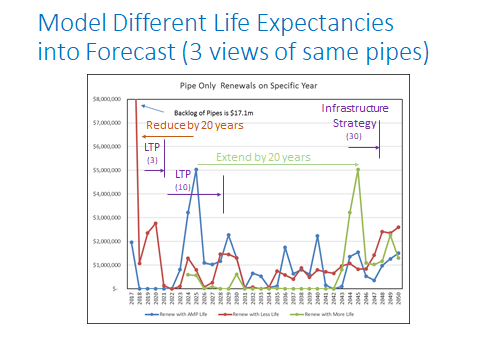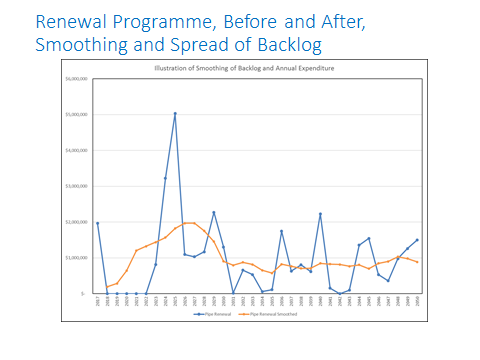Introduction
It is expected that there will be peaks and troughs in the short term annual expenditure forecasts for the renewal of assets, and this may require some smoothing to align with available funding.
However, it is the long term forecasts that have the greatest impact on the overall viability of the utility business and the customer charges that will be required. Providing for growth, level of service change, renewals and improving resilience will all influence the overall long term viability of the provider in amounts and proportions that will vary significantly from provider to provider.
For renewal planning, the predicted cost of renewals (e.g. $/m) should be reasonably reliably predicted from current costs and industry trends. This would need to take into account emerging materials, installation methods and future work constraints.
The most important variable to be determined is, therefore when the renewal is predicted to be required and how that will align with other renewal requirements at that time.
1. Predicted Time of Renewal
The installation date is typically known for most assets, and there will also be a predicted life based on the type of asset. Add the two together and there is the predicted renewal date – Right? – well, sort of.
There is general recognition that estimates of predicted life are, at best, very rough estimates of what will actually occur. The actual life of a pipe is influenced by ground conditions, operating pressures, the quality of construction and maintenance, water quality, the presence of H2S, the pipe material, its diameter, its strength class, etc. and within each of these considerations there will be a probability distribution that ranges from early failures, mean/median failures and late failures.
While we know that these factors will all influence the expected life, we have little robust statistical information to determine by how much, which parts of the network are subject to particular influences, and to what degree.
Another consideration impacting on predicted life is the variable definition of ‘death’ for a pipe. This might relate to a certain frequency of failure or an expectation that the pipe is no longer compliant with health standards. You will see more discussion of this in the short term planning section, but it might also influence long term planning.
Where there is a discernible difference between assets, this should be built into the predictions by including provision in the database that is used.
For example, this might reflect that AC pipes in peat soils last 10 years less than those in clay, or AC pipes larger than 300mm seem to last 10 years longer than smaller pipes. The robustness of these assertions might be challengeable, but it provides a better alignment with observed reality than simply giving them all the same lives. Whatever assumptions are made, make sure these are recorded.
2. Checking Sensitivity
Renewal forecasting is heavily dependent on the predicted lives for assets that are input into the analysis. While there is a certain consistency of life expectancies across the industry, and these are routinely used for valuations and depreciation calculations, there is little hard data to support these estimates. For some material types, the oldest assets are still much younger than the shortest life forecasts, and we simply do not know how they will age.
It is possible to test the sensitivity of the renewal forecasts by inserting life expectancies that are shorter or longer than the current expectation.
This might only be 10 or 20 years either way and might be applied to all assets or just to ones that are assessed to be of interest. The overall value of the long term renewal forecast will largely remain the same, but the timing will change dramatically. You cannot say with any certainty that one or other of the scenarios is more accurate, but you will have a sense of how the numbers change if different assumptions are used.
The graph below illustrates how the current prediction (blue line) changes dramatically if 20 years is added (green line) or subtracted (red line) from the predicted lives of a group of assets. Predicted renewals can move from overdue to just within the 30 year forecast.

3. Providing for Short-Lived Assets
For assets with long predicted lives (say greater than 50 years), a renewal would only occur once, if at all, within a 30 year planning horizon.
However, the renewal of items such as switchboards, with a predicted life of only 15 years, could occur multiple times with the 30 year horizon and the predicted renewal expenditure needs to take this into account. Some asset management programmes can do this automatically. It should also be noted however that while this 15 year predicted life may be acceptable for valuation and depreciation purposes, a longer life may actually be more realistic for renewal planning.
4. Smoothing of Prediction Forecasts
When a renewal forecast is generated, it is not unusual to see distinct spikes in the predicted expenditure and/or the extent of assets to be replaced in a particular year.
As mentioned above, it is most unlikely that all assets of a similar nature and with the same installation date will actually fail in the same year. It is also apparent that actually defining when an asset is determined to be past its ’use-by date’ is a very subjective decision and influenced by many local factors.
Spikes might also be generated by major assets such as treatment plants having large or numerous, sub-assets such as pumps, and these all having the same predicted lives and installation dates. In reality, it is most unlikely that they would be replaced at the same time.
Default dates in the database for the installation of assets can also significantly influence the generation of predicted renewal spikes, and these can be particularly troublesome when the predicted renewals move into the planning period.
All of these factors indicate that the predicted spike is not actually real, and, even if it was, the business would be most unlikely to actually plan to deliver the full extent of the spike in that year.
This means that it is entirely valid to smooth the predicted peak over the adjacent years, and this is actually a much more realistic scenario. A simple tool to achieve this for assets with predicted lives of over 50 years is to allocate 1/9 of the expenditure to the actual predicted year, a further 1/9 to each of the 4 years prior and a further 1/9 to each of the 4 years after. If this is done for each of the years and the spreads then added together, this will generate a smoothed curve that is arguably much more realistic in relation to the actual expenditure profile at that time. There is nothing magic about dividing by 9. It is easily done in Excel and generates a dramatic and more credible outcome. See the following section for a discussion of the backlog that has also been smoothed into the prediction below.

5. Dealing With The Backlog
While it would be possible to limit long term renewal planning to works required beyond, say, 10 years from now, it is usual to include the entire database of assets. Invariably this will reveal assets that have a due date for renewal that is in the past – and this work has not been done.
Collectively these assets are often described as ‘the backlog’, implying that they are renewals that should have occurred but have not.
Generally, these assets will fall into one of 2 categories:
- The renewal should have occurred but has not. Often this may be related to funding constraints.
- The combination of the installation date and predicted life generates a date that is in the past, but there is no apparent reason to actually progress the renewal (see further discussion on Short Term Renewal Planning). You could consider this to be a ‘false positive’.
Inspection of the list of overdue assets, together with maintenance records and input from the maintenance contractor, should determine the status of each individual backlog asset in relation to whether it should actually be considered for renewal in the short term.
The outcome will be the inclusion of renewals that are required into the short term planning forecasts and the spreading of renewals that are not required into the intermediate or longer-term forecasts. Even if the need for renewals seems to be valid, you might still spread the catch-up of the backlog over the next 5-10 years to ease the financial burden.
This process is essentially about merging the long term and short term forecasts, but the need arises from undertaking the long term renewal forecasting.
Long Term Renewal Planning Outcomes - Non-Critical Assets
The process described above seeks to identify the long term funding and resourcing for renewals that the provider must be able to deliver if they are to remain viable and meet all their obligations throughout the planning period.
It focuses on using the best available information and documented assumptions to estimate the rate of deterioration of the assets when their renewal will be required and the cost associated with this. It is not concerned with individual assets but looks at the network as a whole.
The approach recognises that there is a lot of uncertainty associated with the inputs and seeks to understand the impacts of this by scenario modelling. Smoothing is an important tool to convert the raw data into more realistic delivery forecasts.
The information needs to be combined with forecasts for providing for growth, level of service change and resilience to determine the overall funding and resourcing that the provider needs to plan for.
While the discussion above is focused on a defined planning period, e.g. 30 years, the process should also be used to see what is just outside the planning window. This may reveal a future ‘bow-wave’ that needs to be focused on in future planning updates.
Arguably this is the most important planning that a utility provider can do as it goes directly to the sustainability of the service and the viability of the provider. However, it tends to be overshadowed by electoral cycles, a desire to minimise charges in the short term, uncertainty about the future and a perception that the challenges of the future are the problem of future generations.
Long Term Renewal Planning: Critical Assets
The approach used for the long term renewal planning for critical assets is not materially different to that used for non-critical assets. The calculation of the Predicted Time of Renewal, Checking Sensitivity, Providing for Short-Lived Assets, Smoothing of Prediction Forecasts and Dealing with the backlog can all use a similar approach for the assets that have been identified as having an elevated criticality.
A change that can be made is to reduce the predicted life of critical assets to reflect that the asset might be renewed before it begins to fail, and this would be earlier than a non-critical asset.
What is important is that the provider understands which assets have elevated criticality and the rationale for that.
As part of managing assets with elevated criticality, there may need to be more frequent condition inspections and more active management of how they are operated. This recognition will filter into the day to day management of these assets.